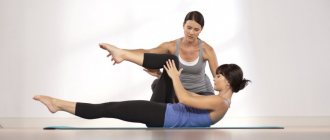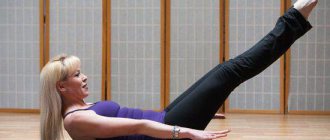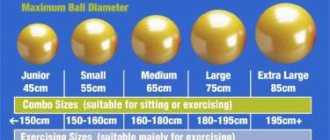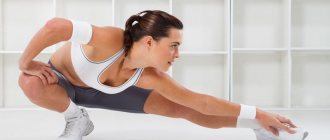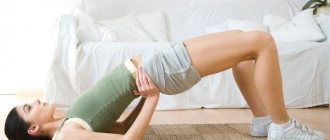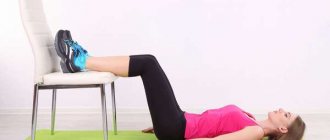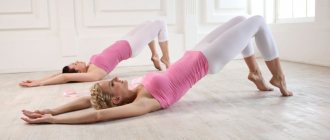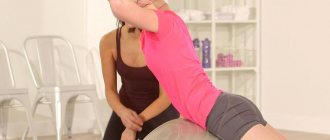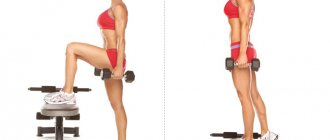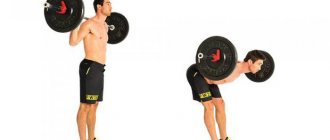Pilates exercises with fitball
Pilates is a type of physical activity that allows you to work out all muscle groups at a measured pace. With the help of Pilates, the muscles of the whole body are strengthened and stretched, while a pleasant feeling of tension is felt, but not fatigue. Pilates is usually performed without additional equipment, but there is such a variation as Pilates on a ball - this type of activity allows you not only to put an equal load on all muscles, but also to relax them. Pilates exercises with a fitball are especially beneficial for the back and spine. To start Pilates exercises with a fitball, you only need a desire, a gymnastic mat and a well-inflated ball. The beauty of a fitball is that it is a strong and unstable surface at the same time, which means that when exercising with its use there is a constant need to keep the muscles tense. Let's start Pilates exercises on a fitball, which will allow you to become more beautiful and healthier. But before you start exercising, don’t forget to do a fifteen-minute warm-up. The exercises presented below are not suitable for beginners. To perform them, you should already be quite familiar with the fitball, be able to keep your balance on it and, at a minimum, not be “afraid” of the ball.
A few important rules
Any gymnastics (and Pilates with a ball is no exception) should begin with mastering several important rules. Otherwise, in the absence of experience, it is easy to get injured. These mandatory requirements for beginners include the following:
It is better to conduct the first lessons with an instructor.- All movements should be smooth - no jerks or excessive efforts.
- You cannot take long breaks from training, otherwise all your efforts will be in vain (the only exception is illness or poor health).
- You need to choose the right ball (the store managers will tell you how its size relates to your height).
- If severe pain occurs, the exercise that caused it should be temporarily excluded from the list.
- Choose the most comfortable clothes and shoes for classes.
- Do not use dumbbells until your muscles are ready for such loads.
Exercise only in a good mood! This can be helped, for example, by your favorite music.
What is the purpose of Pilates with fitball?
- Losing weight. During exercise, many muscles are involved, so the load is higher and calories are burned faster (read more about weight loss exercises HERE).
- Relief formation. Thanks to regular training, you can achieve beautiful abdominal press, and also improve the shape of your buttocks and other problem areas.
- Healthy back. This type of Pilates not only strengthens the back and lower back, but also relieves stress on the spine and promotes the regeneration of intervertebral discs.
- Understanding the body and relaxation. Pilates is always a good mood thanks to meditation and focusing on the sensations in your own body.
Pilates with a fitball has virtually no contraindications. You can come to classes even after injuries to the musculoskeletal system, as well as with excess weight and different levels of physical fitness. Such training is available to people at any age.
We invite you to the Activium Style studio in Moscow for Pilates classes with small equipment. All training is conducted with a personal trainer! Trial lesson - with a significant discount!
Pilates on balls - benefits
What benefits will a good Pilates routine bring to your body? Among the main advantages are:
joints gain much better mobility, and muscles and ligaments gain strength and elasticity;- correction of posture and gradual weight loss - provided that exercise is combined with proper nutrition (an important point for girls and women);
- stabilization of metabolism;
- improving the functioning of the cardiovascular system;
- gradual cessation of back pain (if any);
- activation of blood circulation in the pelvic area (important for intimate health);
- versatility of impact on a wide variety of muscle groups.
The benefits of exercising with a fitball
- Development of coordination and vestibular apparatus - the body reacts to instability of position.
- Strengthens muscle tissue, including the corset muscles, core muscles and deepest tissues.
- Improved posture, restored back and reduced pain.
- Increasing flexibility through constant but safe stretching of joints and muscles.
- Relieving stress and calming the nervous system.
How to choose a Pilates ball
Fitness balls (also used in Pilates), depending on their size, are divided into two types:
fitballs – with a diameter from 45 to 90 cm;- miniballs are small, from 10 to 20 cm, but heavy, from 1.5 to 2 kilograms.
How to choose the right ball?
- The small one should fit comfortably in your hand.
- Large is selected according to height (the simplest formula is height minus 110).
- The material is only high-quality polymer (ideally PVC, a little worse - latex, the most budgetary - rubber).
The kit must include a pump.
Be sure to check out the article “Everything you need to know about choosing a fitball“
Ball selection
For girls whose height exceeds 1m 60 cm, balls with a diameter of 65 cm or more are suitable, and those who are shorter should choose a 55 cm fitball. To be sure of the right choice, sit on the ball. In this case, your knees need to be bent so that they are above your ankles. Ideally, your thighs should be parallel to the floor.
The last argument in favor of the fitball: deep muscles work only on balancing equipment. On exercise machines, a bench or seat works instead, so a fitball is simply necessary for training them.
Pilates with a ball from Alena Mordovina
Returning to the main topic of our article – video lessons – it should be noted that the best specialists in the world produce entire courses of them. For example, the famous trainer and strongest woman on the planet Alena Mordovina filmed more than a hundred of them (a separate lesson for working with a specific muscle group). Among them there is Pilates on a ball - video lessons aimed at working deep muscle fibers and creating a slim figure.
In addition, Alena always accompanies demonstrations of exercises with detailed comments, which greatly help beginners master the basics of the Pilates technique, as well as breathe correctly and learn a psychological attitude.
Basic ball exercises
- Twisting. Lie with your middle back on the ball and bend your knees. The body should be in a straight line. Bend your elbows and place your hands behind your head without clasping your palms. In this position, begin to lift your shoulder blades and head. Go back. Repeat 10 times. You can also perform reverse crunches, where you lift the ball with your feet while lying on the floor.
- Bridge with rifts. Lie on the floor with your arms at your sides and your palms down. Bend your knees and place the ball under your feet. As you inhale, press your feet against the fitball and lift your buttocks with your back to achieve a straight body line. Hold this position for 5 inhalations and exhalations and return to the starting position. Repeat the steps five times and at the end roll the ball back and forth, straightening your legs.
- Push ups. Place the exercise ball on the floor and rest your thighs on it. Place your hands on your palms, spreading your arms slightly wider than your shoulders. While stretching your body into a straight line, tighten your abdominal muscles. Bend your elbows and lower your body. Slowly return to the starting position. Repeat 10 times.
- Hyperextension. Lie on the fitball with your stomach, supporting your pelvis. Place your toes on the floor and place your hands behind your head (you can cross your arms over your chest if you wish). Arch your back for a straight line. Return to the starting position.
- Lateral lifts. Take a kneeling position. Lean on the apparatus on your right side and raise your arms, bending them at the elbows. Place the outer portions of your palms on your forehead, keeping your fingers together. As you inhale, tighten your abs, and as you exhale, straighten up, still touching the fitball with your hip. Return to the starting position and repeat the exercise 5-10 times. For increased load, you can lean on only one knee, and straighten the other leg with emphasis on the toe.
- Squats. Take the ball in your hands and lift it above your head with your arms outstretched. Straighten your back, straighten your chest and shoulders, while tightening your stomach and buttocks. Begin to lower your body by bending your knees and moving your pelvis back. Slowly return to the starting position.
Pilates journal
Using a ball in Pilates lessons makes it possible to work more deeply and efficiently with specific tasks, provides a wider range of varying loads, allows you to work on a specific area, relieve tension, correct posture, work with balance - that is, you, as an instructor, will have an expanded “ an arsenal" of tools for your clients' specific needs in addition to general goals. This, among other things, will make your lessons more varied and interesting, which will undoubtedly increase your rating as an instructor.
Pilates with big ball (Fitball) – 1 full day
Large Fitballs are found in probably every fitness club. The ball is an ideal tool for Pilates training: it requires a good sense of balance, forces deep muscles to work even in beginners, introduces elements of play into the activity, and is easy to adapt to any needs. During the day of the seminar, you will enrich your base of exercises, be filled with new ideas and, of course, deepen your understanding of the principles of Pilates.
Pilates with small ball (20-25 cm) – 1 full day
A small ball is a relatively inexpensive and, most importantly, miniature equipment. Such balls are easy to store in the club, even for a group. Small balls, as well as large ones, are widely used in Pilates. They are placed under the pelvis and chest, held in the hands or feet, leaned on them... Countless options! Small Ball - Ideal for increasing thoracic mobility, targeted breathing work, scoliosis correction and challenging balance exercises.
Themes:
- Integrate small equipment to diversify your Pilates class repertoire (as well as functional and strength training) to meet your clients' specific needs in addition to overall goals.
- Techniques for creating group and personal exercises with the ball.
- Theory, practice and analysis of the client's body type.
- Modifications for specific body types.
- A variety of program options to motivate clients.
- Modifications to increase or decrease exercise intensity.
- Analysis of exercises, its functions and the implementation of the purpose of muscle movement.
- Preparation of workouts to improve conditioning, muscle endurance, posture correction, post-rehabilitation.
Practical exercises - improving the instructor's personal technique.
Plan:
Day 1: Small ball, Day 2: Big ball.
Cost of one day : 6,500 (5,000 if paid 2 weeks before April 25).
Cost of two days : 10,500 (9,000 if paid before April 25).
Seminar presenter : Lidia Brazhenko
Venue : fitness club ZUPRE (metro Savelovskaya)
***
The timing, cost of the seminar and additional information can be found in the training.
LiveInternetLiveInternet
—Categories
- Cooking (2823)
- Knitting (2525)
- Poetry (1394)
- Esoterics (1164)
- Humor (1081)
- Health (856)
- Art (843)
- Sewing (737)
- Aphorisms, parables, sayings (477)
- For the soul (440)
- Cottage, garden, vegetable garden (388)
- Movies (380)
- Cats (369)
- Religion, prayers (318)
- Music (300)
- Photos (268)
- Travel (262)
- Psychology (229)
- History (197)
- Useful tips (176)
- Self-care (162)
- Interesting (159)
- Design (136)
- Nature (135)
- Handicrafts (130)
- Famous people (105)
- Weight loss (101)
- Houseplants (92)
- Interior (88)
- Animals (78)
- Architecture (77)
- Fitness, sports (77)
- Politics (70)
- Audiobooks (69)
- Miscellaneous (68)
- Videos (67)
- Fortune telling (49)
- For women (49)
- Housekeeping (43)
- stones and minerals (38)
- Jewelry (37)
- Yoga (33)
- Children (30)
- English language (30)
- Everything for LiRu (23)
- Gygong (10)
- Prose (9)
-Music
—Search by diary
—Subscription by e-mail
-Statistics
Benefits of doing Pilates exercises with a miniball
Research shows that if you perform traditional crunches with a Pilates ball under your lower back, your abdominal muscles will work more effectively by increasing your range of motion while providing excellent support to your back.
Now try this full Pilates mini-ball workout!
Isolation of the abdominal muscles occurs without increasing tension in the back muscles. With optimal use of such a ball, less trained participants in Pilates classes can make their program simpler, while advanced practitioners, on the contrary, can complicate their exercises with the same mini-ball.
Pilates Basics for Weight Loss
To ensure your training is effective, adhere to the following rules from the very beginning:
- You need to do Pilates in a well-ventilated room, clothing should not restrict movement, pleasant music will help you concentrate on the process and enjoy the workout.
- You should start learning Pilates with a complex for beginners, and only after getting a little used to it, move on to programs for losing weight or working on problem areas.
- One of the most important aspects of training is breathing. You need to breathe from the upper part of the lungs, filling the chest as much as possible as you inhale and tensing the muscle corset as much as possible as you exhale.
- It is important to focus on toning your core and abdominal muscles during training.
- It is necessary to accurately follow the instructions regarding the position of the body at the starting point and at the points of fixation - an incorrect position leads to the fact that non-target muscles and tendons are tensed, the desired trajectory is not followed, and the planned impact is not carried out. That is, the lesson will be, at a minimum, ineffective. Incorrect body position is indicated by a feeling of discomfort and lack of pleasure from doing the exercises. You can look in the mirror to control - the correct movements always look logical and aesthetically pleasing.
- If the description of a particular movement does not say anything about the position of the shoulders, they should be lowered and turned out to ensure optimal breathing.
- It is necessary to constantly monitor the position of the head: it cannot be thrown back or lowered, the head must continue the line of the spine.
- You should always try to stretch the spine as long as possible.
Focusing on the area of the body being worked and breathing allows you to strengthen muscles without increasing their volume. Normalizing the functioning of internal organs leads to optimization of metabolism, which cannot but have a positive effect on appearance and body weight.
How to strengthen your back muscles with a fitball
Bending, according to experts, is the most effective gymnastic element to work the back muscles. With the help of a fitball held in your hands (they need to be raised above your head and not lowered), you will increase the load. According to the rules of Pilates, bends left-right and back-and-forth are done with tense abs and at a slow pace, while exhaling - with inhalation you should return to the vertical position. This load, repeated 30-40 times, can complete the workout. Additionally, the back is worked out as follows:
- In a lying position, press the projectile to your chest. As you exhale, begin to slowly lift your body by zones - neck, shoulders, shoulder blades, thoracolumbar region. Breathing is even.
- When you take a sitting position, stretch your hands with the gymnastic apparatus to your toes.
- Exhaling, bend forward, rounding your back.
- As you inhale, straighten up. With a new exhalation, smoothly lie down in the reverse order - thoraco-lumbar area, shoulder blades, shoulders, neck. Repeat 15 times.
